-

人教版新目标初中英语八年级上册How was your school trip教案2篇
“Go for it!” is based on “Task-Based Language Teaching”. It adheres to “The authenticity principle”, “The form-function principle”, “The task dependency principle” and “The principle of learning by doing”. These principles all accord with the demands of curriculum focus.In and of Grade Seven (II), “Go for it!”, students have learned “The Simple Past Tense”. And it appears again in of Grade Eight (I). teaches students more about how to talk about events in the past. In addition, it gives affirmative and negative statements in the past tense, such as the sentence patterns “Did you see …?” “Were there …?” “Did you go …?” As the first part of Unit 8, Section A opens with a picture presenting the last school trip in the aquarium and continues with several step-by-step practice activities, which are all good for students to master “The Simple Past Tense”. Doing well in Section A will help students integrate the new target language with that in Section B. Thus, they can describe the events in the past freely and foster their own ability of reflecting and practicing. II. Teaching ObjectivesTeaching objective is the beginning and aim of teaching activities. According to the overall goal of the English elementary course--- improve students' synthetic ability of language application, which should be based on the development of students’ “Language knowledge”, “Language skills”, “Character building”, “Learning strategies” and “Cross-cultural awareness”. The teaching objectives are described as follows(I). Knowledge objectivesi. Master the simple past tense of regular and irregular verbsii. Recite the new words and expressions about the last school trip in the aquarium, including their pronunciation and intonation

人教版新目标初中英语八年级上册How do you get to school教案2篇
Step Ⅶ Role play ( Work on 1b)1. First ask two students to read the dialogue to the class.Sa: How do you get to school?Sb: Well, I ride my bike to the subway station. Then I take the subway.2. Now work with a partner.Suppose you use two kinds of transportation to get to school \Hangzhou\Beijing... (bus, train, subway, walking, bike, etc.) Tell how you get there. You may use the phrases in 1a.3. Then ask different pairs of students to present their conversations to the class.Step ⅧListening1. Work on 2a(1) First ask students to read the list of information that Thomas wants to know.…where Nina lives.…how far from school she lives.…how long it takes to get to school.…how she gets to school.…what she thinks of the transportation.(2) Tell students what transportation and bus stop mean.bus stop 汽车站 transportation n. 运送;运输Then tell students we'll hear a recording. Please put a checkmark in front of each thing that Thomas wants to know.(3) Now play the recording for students.( Have students pay attention to the sample answer.) (4) Then correct the answers.

人教版新目标初中英语八年级上册What’s the best radio station教案2篇
教学重点和难点:运用所掌握的语言描述,比较不同地点的特点。在练习中学习掌握英语比较级和最高级的用法。课前准备分配小组,每组五至六人。通过上网或翻阅报刊杂志等方法,确定旅游线路,做出基本的旅游计划。教学设计:本节课流程图 学法指导:1.由于这是一堂新课,在教学中应注意面向全体,发挥学生的主体性,引导学生积极参与,激发学生的求知欲和学习积极性,指导学生积极思维,主动获取知识,养成良好的学习方法。逐步学会独立解决问题。总之要尽可能调动学生的非智力因素促进智力因素的发展。教法选择:1.电化教学法2.课堂讨论法3.任务型教学法采用这些方法的目的是为了充分调动学生的学习积极性,使学生变被动学习为主动学习。通过电脑形象的演示,加强印象,提高兴趣,突破难点,提高教学效率,进而增大教学的容量和信息量。充分体现教师为主导,学生为主体的教学原则。

人教版新目标初中英语八年级上册Can you come to my party教案3篇
Step 3 (3b)First, tell the students when we talk about our future plans, we often use: I’m+verb+ing When we talk about what we must do, we use have to. Ask the students to fill in the blanks in 3b. The answers are: shopping, go to see, a test, I’m going, my family. Step 4 (3c)Let the students write an e-mail message to a friend. Say why you can’t visit next. Before the exercise, ask the students to give some possible answers and write them on the blackboard. So the students will feel easy to finish the writing exercise. After they finish it, Let them to correct it in groups first. Each group chooses theirs best one to read in front of the whole class. Step 5 ( planning a party )First read the conversation in the box together. Then ask the students to turn to page 88.Write down everything you have to do next week. Write in all the things you have to do . Ask the students to look at the list. Ask them “What day are you free?” This is when you can have your party. Step 6 (Self check 1 )Let the students to fill in the blanks with the words given. Change the forms of the words if possible. Then make their own sentences. The answers are: visit, playing, have to, study, comeStep 7 (Self check 2)Imagine you are Marie. Read the information and look at your schedule. Write replies to the invitation.

人教版新目标初中英语八年级上册Could you please clean your room教案3篇
一、 教学内容Section A 1a----1c二、 教学目标1.学习词汇do the dishes, make the bed, take out the trash, fold the clothes, do the laundry, sweep the floor, clean the living room.2.句型 Could you please clean your room? Yes, sure.三、 教学准备 学生预习本单元所有的词汇多媒体课件 活动表 奖品四、 教学过程Pre-task1. Warming upEnjoy ourselves. Watch cartoon Cinderella. 看动画片段《灰姑娘》导如入本课话题和新词汇“chores”美丽善良的鬼姑娘因继母的嫉妒,每天得做所有的家务。片段的主题使学生联想到本课的话题。2. learn new words and phrasesLook! What is she / he dong? 看图学习动词词组do chores, do the dishes, make the bed, take out the trash, fold the clothes, do the laundry, clean the living room.3. Guessing game.What is she doing ? 4. Pair work. 1a, Do you do these things at home? Write “Y” for “yes” and “N” for “no”.5. Listening . 1b , Peter’s chores or Mom’s chores?理解目标语Could you please clean your room? Yes, sure.Write “M” for Mom’s chores, “P” for Peter’s chores in the chart.6. PairworkLook at the picture,Ask your partner to do the chores that you see. 7. Interview Who is the most able at home? 1) What chores do you do at home? How often do you do the chores? Work in four, interview each of the students in the group, fill in the chart.

人教版新目标初中英语八年级上册I’m more outgoing than my sister教案2篇
1 交通工具的比较此活动为小组活动。学生通过讨论找出到达某一城市可乘坐的各种交通工具,并选择最佳出行方式。Teacher:We’re going to Shanghai. How many ways can we use to get there? Yes, there are four ways: by bus, by plane, by train, by ship. Please discuss how you are going to get there.操作建议:(1)学生以小组为单位展开活动,谈论本组所选择的交通工具。(2)各组选代表向全班汇报,阐述本组所选择的交通工具的利和弊。完成任务所需要的语言结构:We can go there by ship. It’s more comfortable and cheaper than any other transportation.We can go there by bus. It’s cheaper but it takes longer time.2 哪个城市更合适?此活动具有挑战性。假设中国要举行2014年世界杯足球赛,分别从历史,人文,天气等方面对各城市(北京,大连,上海,昆明)进行比较,选择最佳举办城市。T: Imagine China is holding the 2014 FIFA World Cup. Which city do you think is the best for the World Cup, Beijing, Dalian, Shanghai or Kunming? Let’s work in groups. If you choose Beijing, please join the Team Red. If you chose Dalian, please join the Team White. If you choose Shanghai, please join the Team Blue. If you choose Kunming, please join the Team Green. Please show us its advantages. Then let’s see which team will win.

人教版新目标初中英语八年级上册How do you make a banana milk shake教案2篇
1. First, ... then, ... next, ... finally, ...首先,……然后,……接着,……最后,……这是英语中表达做某事的步骤的一种说法。如果步骤较多,还可以说:first-next-after that-later on-finally/at last通常你会听到说英语国家的人在说 first, next, then, finally 和后面的内容时,他们会做一些停顿。这样就能提前告诉听者接下来讲的是一系列的步骤。这一点在朗读和听力中应特别注意。2. how many, how much均为疑问词,同是“多少”,但用法不同。请看:how many修饰可数名词复数,how much修饰不可数名词。但在用法上,同学们常犯如下错误:1) [误] How many are there bananas on the table?[正] How many bananas are there on the table?[析] how many, how much 中的many,much是形容词,常修饰名词作定语,故后面跟名词。2) [误]How much tea are there on the table?[正]How much tea is there on the table?[析] how much修饰不可数名词时,谓语动词用单数。how many与how much的区别可简记为:前how many:问“多少”,复数名词后面跑;how much问“多少”,不可数名词单数好。前者答语用基数词,后者答语用数量关系。

人教版新目标初中英语八年级上册What are you doing for vacation教案2篇
Teaching goals : 1. Words & phrases: babysit ,get back , fishing , rent , think about , decide(on) , tourist etc. 2. How to talk about future plans . 3. 现在进行时表示将来计划或行动. 4. 特殊疑问句(where , when , how long引导) Important and difficult points : Drills :What are you doing for vacation ? I’m watching TV . When are you going ? I’m going … . How long are you staying ? We’re staying for five days . Teaching aids : cards and a tape ,a large wall calendar . Period 1 Teaching procedures : Step 1Leading in1. Free talk . 2. Put up the wall calendar . T: I’m staying home on Saturday (pointing to next Saturday ).Ss repeat . Ss: I’m staying home on Saturday . T: OK. Today we’ll learn how to talk about future plans. Step 2Pre-task SB Page 13 , 1a . 1. Look at the picture carefully and tell what you see in the picture . 2. Write the activities from the pictures in the box and add some more . 3. Practice reading . Step 3While-task1. Using the activities we write in 1a to make conversations .For example :What are you doing for vacation ? I’m visiting my uncle . 2. Pairwork .Practice in pairs . 3. 用第三人称练习对话.

人教版新目标初中英语八年级上册What’s the matter教案2篇
She shouldn’t go to the party tonight.Step7. TaskT: You know, there are lots of problems in our life. If you are a doctor, please tell us how to solve the problem. I will divide you into 9 groups. Please work in groups. And then choose one of you to report your ideas.The following are the problems:I have a toothache.I am hungry. I have a sore throat.I am stressed out. I have a sore back.I am tired. I can’t sleep.I have a cold. I have a headache.Report: If you have a headache, you should go to bed early. You should see the doctor. You should eat some medicine. You shouldn’t wash your face with cold water.You shouldn’t sleep late.You shouldn’t swim.…..T encourages the students to give advice as much as possible.Homework:1. Chose one of the problems, and write down your advice2. Copy the new words这一步是用于热身的,同时也可以让他们复习一部分的表示人体部位的单词,扩充知识.学习语言的过程也是一个不断积累的过程,复习旧知识,增添新知识.通过小游戏,强化学生对Does she/he have…这个句子的运用能力.通过复习,自然的引到下面新知识的学习。充分利用表格,由句子到对话,再到文章,让学生循序渐进. 提高学生的综合语言运用能力,运用以前学过的知识来解决身边的问题.Period 5 (Section B 3a—3c, selfcheck)教学内容与分析:

人教版新目标初中英语八年级上册I’m going to be a basketball player教案3篇
教学目标1.知识目标:(1)学习What are you going to be when you grow up?/How are you going to do that?句式。(2)学会用英语描述有关职业的表达法。2.能力目标:(1)能够谈论为实现理想所做出的打算和安排。(2)能够谈论未来自己与他人理想的职业及原因。(3)能用英语描述课余时间的活动安排,最终具备表达综合信息的能力。3.情感目标:新学期到来之际,让他们在学习、体育、饮食、特长、读书等方面制定计划,教育学生合理安排自己的课外生活,思考自己的理想职业及适合自己的职业。教学重点、难点本单元的重点为“be going to”表将来,want to be, what,where, when,how引导的特殊疑问句。难点是语言目标的实现。教材分析本单元以I am going to be a basketball player为话题,共设计了三部分的内容:一、Section A该部分有4个模块。第一模块围绕Do you think these jobs are interesting?这一话题展开思维(1a)、听力(1b)、口语(1c)训练;
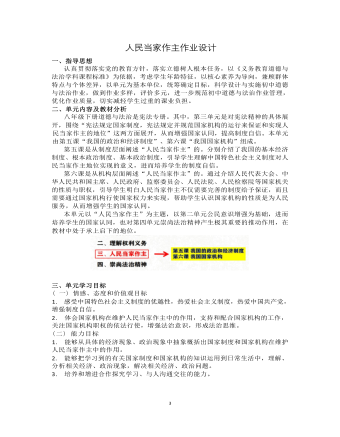
道德与法治八年级下册人民当家作主作业设计
①坚持依法行政,维护公平正义②严格遵循诉讼程序,加强立法③司法过程和结果都要合法、公正④坚持以事实为根据,以法律为准绳A.②④ B.②③ C.③④ D.①②3.疫情防控期间,某地检察院充分发挥检察职能,与公安机关等部门加强协作, 提前介入涉疫案件侦查,切实保障人民群众合法权益,全力维护疫情期间社会稳 定。由此可见 ( )①人民检察院是我国的法律监督机关②公安机关是我国的审判机关③公平正义需要法治的保障④人民检察院接受政府的领导和约束A.①② B.①③ C.②③ D.②④(二) 非选择题4. 探究与分享:结合所学知识,与同学讨论探究,回答下列问题。案例反思:2017 年 4 月 20 日,最高人民法院、中央电视台联合公布 2016 年推动法治进程十大案件评选结果,聂某被宣判无罪案等十大案件入选。1995 年 3 月,石家庄中院一审判处聂某死刑,同时判处赔偿受害人家属丧葬费等计 2000 元。1995 年 4 月 27 日,聂某被执行死刑。2016 年 12 月 2 日,最高人民法 院第二巡回法庭宣告撤销原审判决,改判聂某无罪。2017 年 3 月,聂某家属获 268.13991 万元国家赔偿。思考:如何才能避免这种错案的发生?
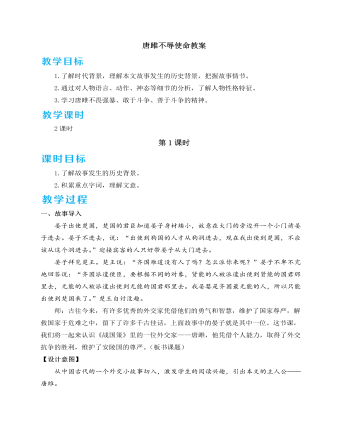
人教部编版语文九年级下册唐雎不辱使命教案
预设 对比与映衬、渲染与烘托。由于文章始终是在人物对话中展开的,人物语言和行为遵循“刺激—反应”模式平行而下,自然形成了对比,造成了映衬互见的效果。如围绕易地问题,就有秦王的欲求与安陵君的坚守,有秦王的无理狡辩与唐雎的据理抗争;在意志较量方面,则有“天子之怒”与“布衣之怒”的对垒。秦王所说的“天子之怒”,唐雎的“未尝闻”;唐雎所说的“布衣之怒”,秦王归之于“免冠徒跣,以头抢地”。一个拒绝回答,非常傲气;一个丑化描述,极为轻蔑。这样,人物形象对比鲜明,相互衬托,将一场正义与非正义的较量真实而生动地展现出来。作者为了追求夸张、强化的效果,多借助人物语言渲染气势、烘托气氛,增强故事的“现场感”。如秦王说“灭韩亡魏”,目的是从气势上压倒对手;唐雎罗列刺客的壮举,也表明了血拼到底的气概。秦王先说“灭韩亡魏”,气势夺人;后说“韩、魏灭亡”,辞格已卑。这些生动的描写,极大地凸显了人物性格。
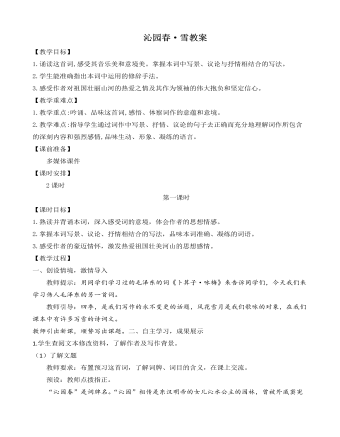
人教部编版语文九年级上册沁园春·雪教案
3. 同学们,我们再从表达方式方面去考虑一下。教师指正:写景、抒情、议论相结合。这是一首雄壮的抒情词作。上阕写景,气势磅礴、气象雄浑,而又寓情于景,句句洋溢着热爱祖国河山的豪情。下阕议论,由评论历史人物转到歌颂当代无产阶级英雄,抒发作者的豪情壮志。全词熔写景、议论和抒情于一炉,使主题鲜明突出,表现出强烈的艺术效果。五、 课堂检测,当堂反馈要求学生当堂做完下列题目,师生再共同订正,看看还有哪些知识没有掌握,教师及时要求学生巩固。六、知识迁移,拓展延伸1. 请同学们下面读一下柳宗元的《江雪》,回答后面的问题。教师:唐代著名文学家柳宗元写过的这首《江雪》,言简意深。请同学们思考分析,这首诗与《沁园春·雪》在感情基调上有什么不同?是什么原因造成的? 教师指正:柳宗元因参加革新运动失败而遭贬,他的政治思想和远大抱负不能实现,内心的苦恼与愤懑反映在诗中,就是那个卓尔不群、孤芳自赏、“独钓寒江雪”的“蓑笠翁”。而毛泽东的词作大气磅礴,格调高亢,充满了热爱祖国河山、以天下为己任的豪情壮志。这种差别,主要是由于作者所处的时代、境遇,特别是胸怀的阔狭造成的。
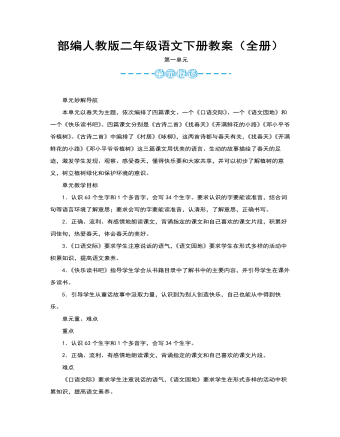
二年级语文下册教案课程全册
本文是一篇语言优美,充满儿童情趣和文学色彩的文章,仿佛呼唤着我们去寻找春天。我们到校园里找一找,也许能在操场边发现刚探出头的小草;我们到野外去找一找,也许能在天空中发现飘飘摇摇的风筝;打开课本,我们还会在课本插图中发现春天的影子;读着课文,我们会感觉自己就是那几个脱掉棉袄,冲出家门,奔向田野的孩子,我们还能体会到寻找春天的急切心情,感受到发现春天的欣喜。二年级学生具有好奇、爱探索、易受感染的心理特点,容易被新鲜的事物、活动的东西所吸引。在一年半的语文学习后,他们已经能够说一段较完整的话,并能在教师创设的情境中体验、感受,达到情感的共鸣,同时也积累了不少生活素材,这些都是学习本课的有利因素。

部编版语文七年级上册《赫尔墨斯和雕像者》说课稿
一、说教材《赫尔墨斯和雕像者》选自人教版七年级上册第六单元《寓言四则》中的第一则寓言,本单元主要是一些有趣的故事,通过故事揭示道理。学情分析:学生在小学已经学过一些寓言故事的基础上,能够联系自己的生活体验积极思考和表达自己的观点。(根据新课标要求、寓言的特征和学生的实际情况)二、说教学目标知识与能力目标:了解寓言以及《伊索寓言》的知识;过程与方法目标:品味描写人物心理变化等细节描写,分析赫尔墨斯的性格特征;情感态度与价值观目标:正确理解寓意,树立正确的人生处事态度。三、说重难点(本单元要求:学习《伊索寓言》时重在让学生揣摩人物的语言、表情。)重点:揣摩人物的心理变化等细节描写。难点:多元理解寓意,培养学生发散思维。
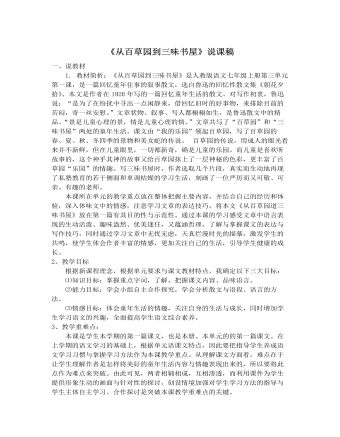
部编版语文七年级上册《从百草园到三味书屋》说课稿
2、教学目标根据新课程理念,根据单元要求与课文教材特点,我确定以下三大目标:⑴知识目标:掌握重点字词,了解、把握课文内容、品味语言。⑵能力目标:学会小组自主合作探究,学会分析散文与语段、语言的方法。⑶情感目标:体会童年生活的情趣,关注自身的生活与成长,同时增加学生学习语文的兴趣,全面提高学生语文综合素养。3、教学重难点:本课是学生本学期的第一篇课文,也是本册、本单元的的第一篇课文。在上学期的语文学习的基础上,根据单元语课文特点,因此要把指导学生养成语文学习习惯与掌握学习方法作为本课教学重点。从理解课文方面看,难点在于让学生理解作者是怎样将美好的童年生活内容与情趣表现出来的,所以要将此点作为难点来突破。由此可见,两者相辅相成,互相渗透,而利用课件为学生提供形象生动的画面与针对性的探讨,创设情境加强对学生学习方法的指导与学生主体自主学习、合作探讨是突破本课教学重难点的关键。
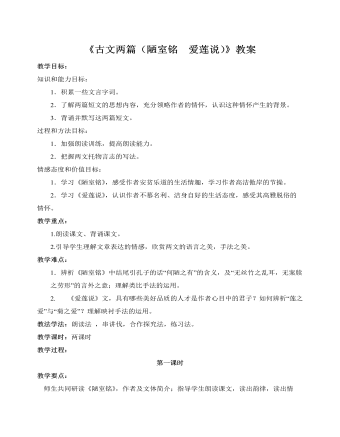
部编版语文七年级下册《古文两篇(陋室铭 爱莲说)》教案
教学目标:知识和能力目标:1.积累一些文言字词。2.了解两篇短文的思想内容,充分领略作者的情怀,认识这种情怀产生的背景。3.背诵并默写这两篇短文。过程和方法目标:1.加强朗读训练,提高朗读能力。2.把握两文托物言志的写法。情感态度和价值目标:1.学习《陋室铭》,感受作者安贫乐道的生活情趣,学习作者高洁傲岸的节操。2.学习《爱莲说》,认识作者不慕名利、洁身自好的生活态度,感受其高雅脱俗的情怀。教学重点:1.朗读课文、背诵课文。2.引导学生理解文章表达的情感,欣赏两文的语言之美,手法之美。教学难点:1.辨析《陋室铭》中结尾引孔子的话“何陋之有”的含义,及“无丝竹之乱耳,无案牍之劳形”的言外之意;理解类比手法的运用。2. 《爱莲说》文,具有哪些美好品质的人才是作者心目中的君子?如何辨析“莲之爱”与“菊之爱”?理解映衬手法的运用。教法学法:朗读法 ,串讲伐,合作探究法,练习法。
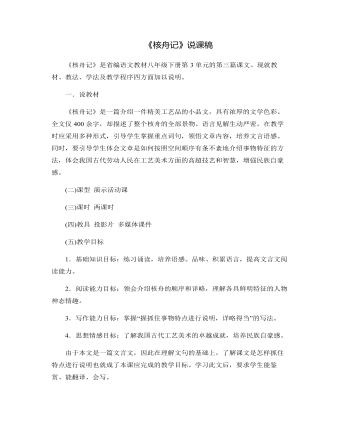
部编版语文八年级下册《核舟记》说课稿
(2)教学内容的设计,一般须遵从学生认知规律,由表及里,由浅入深、完整、生动地呈现事物或事理本身的美学价值。在整体感知课文的艺术美和解决文字障碍之后,通过动手做“核舟”、改写评点“解说词” ,使学生在动手做、动手改、动口说中,理清课文层次和说明顺序。最后,学生们再一次通读全文,使他们的认知经历了从语言文字到形象生动的表象,再到语言文字的完整过程。帮助他们将语言形式和语言内容紧密结合起来。吉尔伯特·海特在其《教学的艺术》一书中曾谈到:“如果我们不能获得一声出自内心的笑,那么这一天的教学就白费了”。通过演课本剧,加深了学生对课文的理解和记忆,有利于培养学生的思考能力,想象能力,逻辑思维能力和语言表达能力。也正是获取一声声出自内心的笑的一种行之有效的方法。
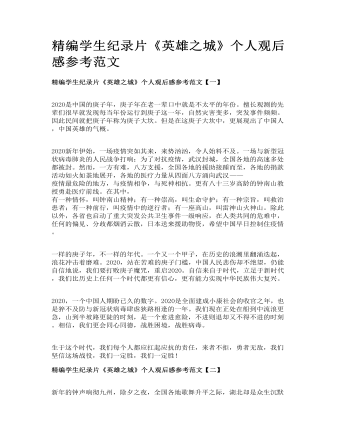
精编学生纪录片《英雄之城》个人观后感心得体会参考范文
2020新年伊始,一场疫情突如其来,来势汹汹,令人始料不及。一场与新型冠状病毒肺炎的人民战争打响;为了对抗疫情,武汉封城,全国各地的高速多处都被封。然而,一方有难,八方支援,全国各地的援助接踵而至,各地的捐款活动如火如荼地展开,各地的医疗力量从四面八方涌向武汉——疫情最危险的地方,与疫情相争,与死神相抗。更有八十三岁高龄的钟南山教授勇赴医疗前线。在其中,有一种情怀,叫钟南山精神;有一种崇高,叫生命守护;有一种宗旨,叫救治患者;有一种前行,叫疫情中的逆行者;有一座高山,叫雷神山火神山。除此以外,各省也启动了重大突发公共卫生事件一级响应,在人类共同的危难中,任何的偏见、分歧都烟消云散,日本送来援助物资,希望中国早日控制住疫情。
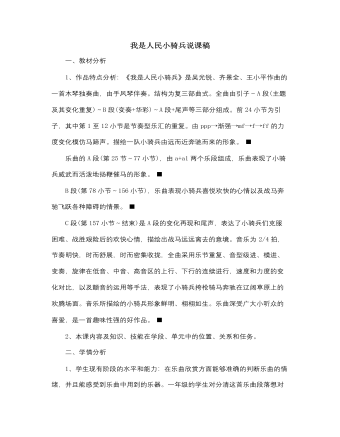
人音版小学音乐二年级下册我是人民小骑兵说课稿
教师与学生有导有游,避免了以往欣赏课教学中枯燥的让学生完整听,分段听,机械式的讨论欣赏,增加了情趣,用不同的音乐活动表现不同的段落,让学生清晰各个段落的旋律与表现内容。2、本课成功之处:创设良好的学习情境,营造良好的学习氛围。学生在学习过程中,通过舞蹈、器乐伴奏等表演感受到了音乐段落的变化,学生清楚的分清段落层次。3、本课失败之处:舞蹈动作的创编如果能更加生动,体现出小骑兵的神气活现会更好。4、生成问题:学生在合作表演时,打击乐器的节奏容易不稳,教师提醒学生注意的同时可以带领学生一起敲击控制好节拍。最后为了丰富学生对音乐的体验,我在这一部分让学生通过欣赏歌曲《草原英雄小姐妹》,感受蒙古音乐的节奏特点,体验并升华情感。5、今后调整思路:舞蹈动作可以创编更生动更有表现力的动作,丰富学生的感受和表现力。


